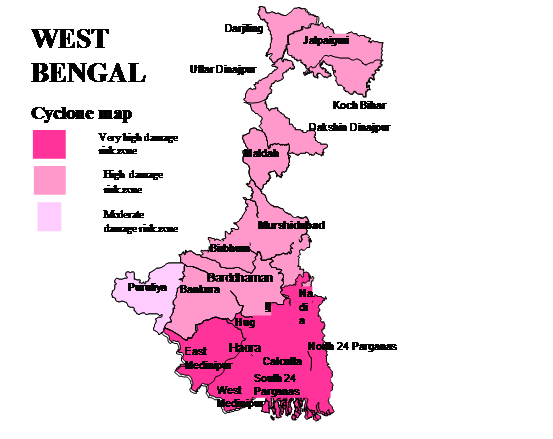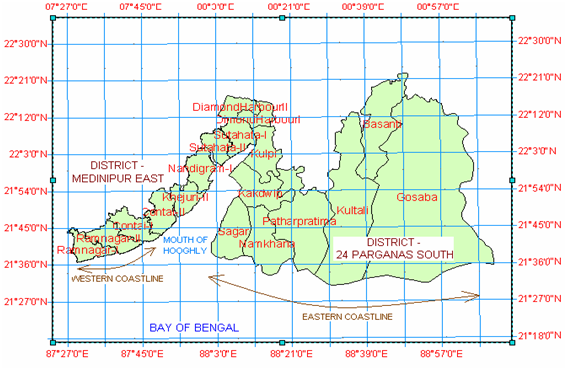Overview
It is an intense vortex or a whirl in the atmosphere, characterized by high winds
rotating about a calm center of low atmospheric pressure in anti-clockwise direction
in the Northern Hemisphere and in clockwise direction in the southern Hemisphere.
This center moves onwards and pressure increases outwards. The force of the pressure
in the center and the rate at which it increases outwards gives the intensity of
the cyclone and the strength of winds.
Formation
Cyclones form in certain favourable atmospheric and oceanic conditions. There are
marked seasonal variations in their places of origin, tracks and attainment of intensities.
These behaviours help in predicting their movements. Pre and Post mosoon storms
are more violent than the storms of the monsoon season.
The coastal stretch of West Bengal is necessarily highly vulnerable to cyclone.
The phenomenal storm surge in coastal West Bengal is due to its peculiar bathymetry
and nature of coastal belt. The northern part of the Bay of Bengal is very shallow.
The coast is also landlocked on three sides. As a result when a very severe cyclonic
storm or a hurricane approaches the coast, the enormous storm surge generated by
the wind pressure submerges the coastal belt at the time of the storm crossing the
belt. The frequency of storms crossing this belt is also high. Another peculiar
characteristic of this coast is that it is crisscrossed by innumerable rivers and
rivulets, with the elevation of the islands about 4 to 5 meters. The seadykes and
embankment are not strong enough to resist strong wind-driven waves and naturally
cave in during depression / cyclonic storm situation.
Onset Type:
They strike suddenly although it takes time to build up. They can be tracked on
the development but accurate landfall is predictable barely within few hours. The
onset is extensive and often very destructive.
Cyclone Accompanied by Sea Wave:
A heavy cyclone accompanied by a sea wave, is the worst kind of disaster which may
occur in this delta. Disasters of this kind have caused appalling mortality in the
past and will possibly do so again. Practically, nothing can be done to avoid them
but fortunately they are not frequent.
They are most likely to occur at the beginning or at the end of rains, i.e., either
before the winter paddy is planted or at a time when it is almost ripe. Under such
circumstances the damage to crops may be small in comparison with the mortality
among men and cattle which may be enormous. The maritime districts of West Bengal
are liable to storm waves but the districts of 24 Parganas has suffered most severely.
Elements at Risk:
All lightweight structures and those built of mud, wood, older buildings with weak
walls and structures without proper anchorage to the foundations will be at great
risk. Settlements located in low lying coastal areas will be vulnerable to the direct
effects of the cyclones such as wind, rain and storm surge. Settlements in adjacent
areas will be vulnerable to floods, mud-slides or landslides due to heavy rains.
Other elements at risk are fences, telephone and electricity poles, cables, light
elements of structures – roofs, signboards, hoardings, coconut crowns, fishing boats
and large trees.
Occurrence of Cyclone:
West Bengal has two Cyclone seasons – pre-monsoon and post-monsoon cyclone during
April-May and Nov-Dec, respectively. Pre-monsoon cyclone, which causes wide spread
hailstorm and it is traditionally called n the state as Kalbaishaki. Paschim Medinipur,
Purba Medinipur, South 24 Parganas, North 24 Parganas, Howrah, Hooghly, part of
Nadia, Burdwan and Bankura are located in very high damage risk zone (V=50m/s) with
respect to Cyclone; whereas a major part of Nadia, Burdwan, Bankura, Murshidabad,
Malda, Uttar and Dakshin Dinajpur, Jalpaiguri, Cooch Behar, Darjeeling, part of
Purulia encounter with high damage risk zone (V=47m/s). Major portion of Purulia
falls under moderate damage risk zone (V=29m/s) with respect to cyclone.
Typical Effects:
First, in a sudden, brief onslaught, high winds cause major damage to infrastructure
and housing, in particular fragile constructions. They are generally followed by
heavy rains and floods, and in flat coastal areas by storm surge riding on tidal
waves and inundating the land over long distances of even upto 15km inland.
- Physical damage -Structures will be damaged or destroyed by the
wind force, flooding and storm surge. Light pitched roofs of most structures especially
the ones fitted on to industrial buildings will suffer severe damage.
- Casualties and Public Health – Caused by flooding and flying elements,
contamination of water supplies may lead to viral outbreaks, diarrhea and malaria.
- Water supplies – Ground and piped water supply may get contaminated
by flood waters.
- Crops and Food Supplies – High winds and rains will ruin the standing
crop and food stock lying in low lying areas. Plantation type crops such as banana
and coconut are extremely vulnerable. Salt from the sea water maybe deposited on
the agricultural land and increase ht salinity. The loss of the crop may lead to
acute food shortage.
- Communication – Severe disruption in the communication links as
the wind may bring down the electricity and communication towers, electricity and
telephone poles, telephone lines, antennas and satellite disk and broadcasting services.
Transport lines (road and rail) may be curtailed. Relief materials may not reach
the affected site.

Special Nature of the Problem
Though the frequency of Tropical Cyclones in the North Indian Ocean (NIO) are the
least in the world (7% of the global total), their impact on the coasts bordering
the North Bay of Bengal (North of 150 N latitude) in West Bengal are extremely disastrous.
The problem can be fathomed from the fact that during the past two and a half centuries,
20 out of 23 major cyclone disasters (with human loss of life 10,000 or more and
not considering the damages) in the world have occurred over the Indian Subcontinent
(India and Bangladesh). One of the major reasons for this is the serious storm tide
problem in these coasts. A tropical cyclone of specific intensity when it strikes
the east coast of India and Bangladesh, usually produces a higher storm surge compared
to that when such a cyclone strikes elsewhere in the world. This is because of the
special nature of the coastline, the shallow coastal ocean topography and the characteristics
of tide in the North Bay of Bengal region.
International Classifications of Storms
|
Low Pressure Systems Wind
|
Speed in Kms. Per Hour
|
|
Depression
|
36 – 55
|
|
Deep Depression
|
56 – 66
|
Cyclonic Storm
Severe Cyclonic Storm
|
67 – 96
96 – 117
|
|
Severe Cyclonic Storm with core of Hurricane
|
> 117
|
Vulnerability to Cyclones:
Cyclones are natural events, which cannot be prevented. What actually makes these
hazards turn in to disasters is the vulnerability of the people and their means
of livelihood and the fragility of infrastructure. The Indian Sub-continent is the
worst affected part in the world as far as loss of lives is concerned though more
severe cyclones do occur in other parts of the world and financial losses are much
more elsewhere. This could primarily be attributed to the special nature of the
problem discussed above and the vulnerability of the people. High population density,
comparatively better employment opportunities and economic compulsions force people
to occupy, areas, which are susceptible to cyclones, saline ingress and flooding.
Traditional coping mechanisms have been the mainstay for these people to counter
hazards, but during major disasters these coping mechanisms are found wanting. Though
communities have a natural tendency to face hazards by joining hands, they usually
fail to generate the desired synergy because of unsystematic and ad hoc approaches.
On many occasions people are not even aware of the risks involved. The frequent
disasters nullify the development of several years and turn the clock back for these
vulnerable families.
Number of Cyclones Crossing West Bengal Coast during 1891- 2000
|
Station Coastal Districts
|
No. of Cyclonic storms
|
|
24 - Parganas (North & South)
|
35
|
|
Midnapur (East & West)
|
34
|
Historical records of 3 most devastating cyclones, which formed in the Bay of Bengal
and made landfall on the coast of West Bengal
|
1.
|
7-12 October,1737
|
Super Cyclone*
|
Crossed West Bengal coast over Sunderbans
Surge height: 12 m
Loss of life: 300,000
|
|
2.
|
2-5 October, 1864
|
2-5 October, 1864
|
Cross the coast near Contai, West Bengal Surge Height: The wave in many places rose
to 9 m The Maximum height of the waves reached 12 m. At Sagar Island it was 5 m
above land level. At Diamond Harbour, the wave was 3 m Loss and Damage: People Killed=50,000
(mostly due to drowning), and 30,000 (due to diseases as a result of inundation)
|
|
3.
|
14-16 October, 1942
|
Severe Cyclonic Storm
|
Crossed West Bengal coast near Contai Surge Height: 3-5 m Loss and Damage: People
Killed=19,000, Cattle heads killed=60,000
|
|
4.
|
23-26 May, 2009
|
Severe Cyclonic Storm
|
Crossed close to the east of Sagar Island Surge Height: 3-5 m Loss and Damage: People
Killed=137, Cattle heads Killed= 50,000
|
COASTLINE OF WEST BENGAL TOUCHING BAY OF BENGAL

Impact on the Coastal Eco-System:
“Coastal ecosystem” includes estuaries and coastal waters and lands located at the
lower end of drainage basins, where streams and river systems meet the sea and are
mixed by tides. The coastal ecosystem includes saline, brackish (mixed saline and
fresh) and fresh waters, as well as coastlines and the adjacent lands. All these
water and landforms interact as integrated ecological units. Shore-lands, dunes,
sandbars, offshore islands, headlands, and freshwater wetlands within estuarine
drainages are included in the definition since these interrelated features are crucial
to coastal fish and wildlife and their habitats. Mangroves are located all along
estuarine areas, deltas, tidal creeks, mud flats, salt marshes and extend over 4871
sq. km (about 7% of world’s mangrove areas). Impact of global warming- induced sea
level rise due to thermal expansion is more pronounced in the Bay of Bengal due
to the shallowness of the waters. The entire coastal ecosystem in general and the
eastern coast in particular are highly vulnerable due to flat and low terrain, high
population density, over exploitation of natural resources, high rate of environmental
degradation on account of pollution and non-sustainable development. On many occasions,
the livelihood requirements of people are detrimental to maintaining the delicate
balance of the fragile coastal ecosystem. Degradation of the eco-system not only
affects the environment adversely, but also makes the people living in the coastal
areas more vulnerable.k